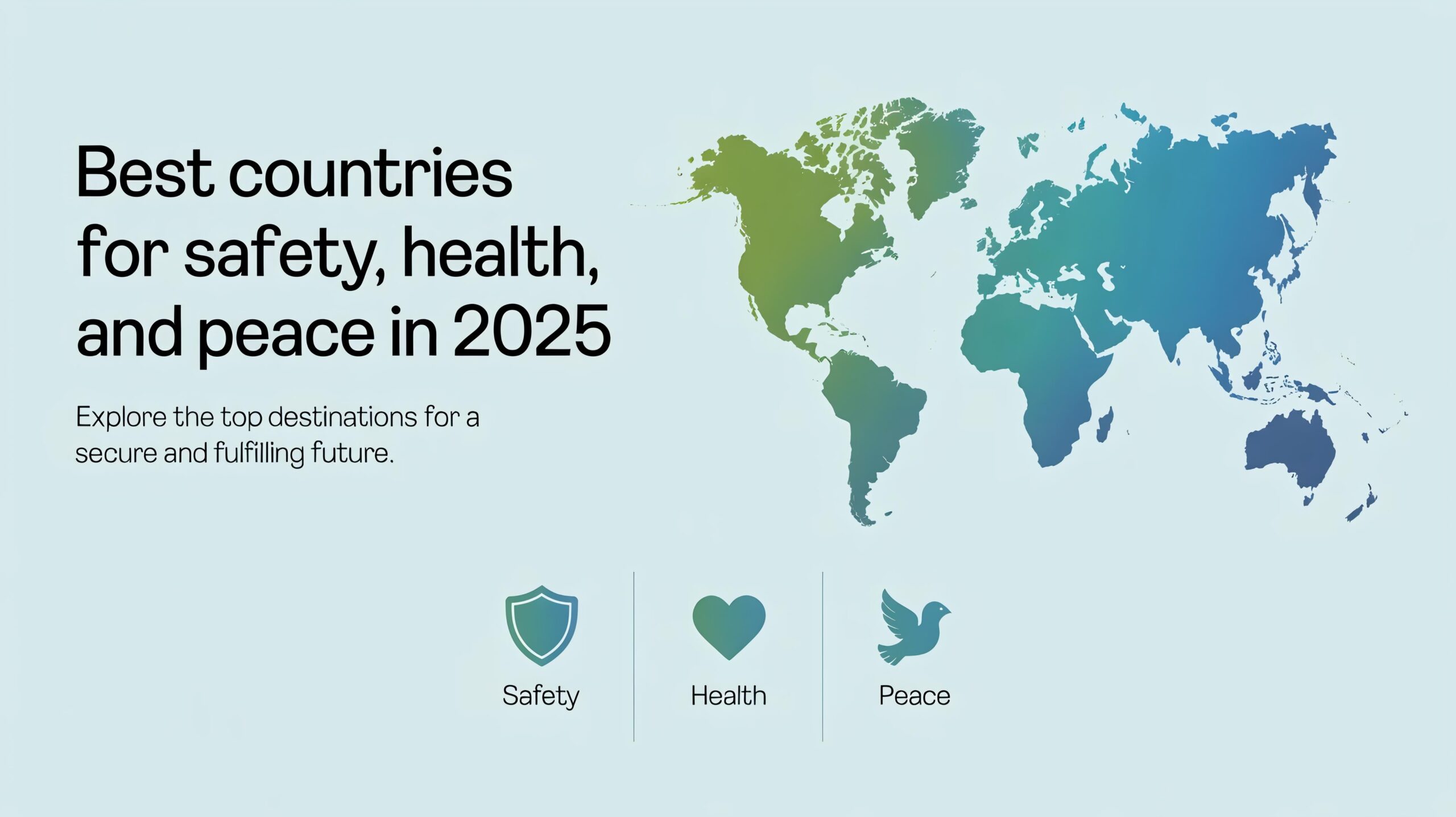In a world where the news often sounds like a scene from a disaster movie, there are still countries where life feels calm and safe. In these peaceful places, people leave their doors unlocked, walk home late at night without fear, and police officers spend more time helping people than fighting crime.
Welcome to the safest countries in the world in 2025—places where peace, trust, and safety are part of everyday life.
Check out: Exploring Romantic Destinations in India | Best for Lovers
What Makes a Country Safe?
The Global Peace Index 2024 ranks 163 countries based on 23 factors, like crime, conflicts, and government stability. The safest countries have:
- Wealth and good economies
- Strong healthcare and education
- Fair justice systems
- Low poverty and crime
- Stable governments
- Little or no war or conflict
- Clean and safe environments
Here are the Top 10 Safest Countries in 2025, ranked by their Peace Index Score (lower scores mean more peace).

1. Iceland – Peace Index Score: 1.112
Iceland is the safest country in the world and has been since 2008. This small island in the North Atlantic has very little crime and no army.
- Safety: Very low crime and peaceful people.
- Health: Icelanders live long lives (average 82.6 years). Healthcare is mostly free, publicly funded.
- Environment: The air is clean, and there are few dangerous animals. Earthquakes and volcanoes happen, but they rarely affect people.
2. Ireland – Peace Index Score: 1.303
Ireland moved up to second place in 2024. Its police, called Garda Síochána (“guardians of the peace”), keep the country safe. Ireland has a strong economy and welcomes newcomers.
- Safety: Crime is low, Ireland is very safe overall.
- Health: Ireland spends €25.8 billion on healthcare in 2025, making it accessible to everyone.
- Environment: Cleaner cities, air quality is improving, and Ireland plans to cut carbon emissions in half by 2030.
3. Austria – Peace Index Score: 1.313
Austria is third, with low crime and a strong justice system. It spends only 4.23% of its money on violence-related issues, one of the lowest rates in the world.
- Safety: Serious crime is rare, but minor crimes like pickpocketing are up slightly in cities like Vienna.
- Health: Healthcare is almost free for everyone, funded by taxes and insurance.
- Environment: Austria aims to be carbon-neutral by 2040, but greenhouse gas emissions are still a concern.
Discover: Ambani Lifestyle Expenses: Antilia, Private Jets, Security & More
4. New Zealand – Peace Index Score: 1.323
New Zealand is the safest country in the Asia-Pacific region. Its small population (5.1 million) helps create strong, safe communities.
- Safety: Crime is very low, and people are friendly and welcoming.
- Health: Healthcare is free or low-cost for most residents, with $16.68 billion budgeted for 2024–2026.
- Environment: Rising sea levels cause some flooding, but New Zealand aims for net-zero emissions by 2050.
5. Singapore – Peace Index Score: 1.339
Singapore jumped to fifth place in 2024. This city-state has strict laws that keep crime low and is very safe.
- Safety: Serious crime is rare, but watch out for pickpockets in busy areas.
- Health: Healthcare is top-quality, but insurance is needed for full coverage.
- Environment: Air quality is good, but faces pollution during forest fire seasons (August to October).

6. Switzerland – Peace Index Score: 1.357
Switzerland is known for staying neutral in global conflicts and wealthy. It has one of the lowest crime rates in the world.
- Safety: Violent crime is almost missing, Even in major cities like Zurich and Geneva, residents report feeling safe walking alone at night..
- Health: Healthcare is world-class, and people live long lives (average 84.3 years).
- Environment: Switzerland recycles 70% of its waste and has clean air and water. It aims for carbon neutrality by 2050.
7. Portugal – Peace Index Score: 1.375
Portugal has become much safer since its economic recovery after 2014. It’s now a model of peace in Europe.
- Safety: Violent crime is low, no recent terrorist attacks, and peaceful society.
- Health: Healthcare is free for all, and drug policies focus on treatment, not punishment.
- Environment: Few natural disasters, including wildfires, are issues, but air quality is improving in cities.
Visit: Secrets of Success: 10 Habits of the World’s Richest People
8. Denmark – Peace Index Score: 1.383
Denmark is one of the happiest and safest countries. Its welfare system and trusting communities make it peaceful.
- Safety: Crime is low, and a strong social support system.. Most people feel safe walking alone at night.
- Health: Healthcare is free, with short waiting times for treatments.
- Environment: Denmark has clean water and strong green policies.
9. Slovenia – Peace Index Score: 1.396
Slovenia, a small country in Central Europe, is safe and stable despite being independent only since 1991.
- Safety: Crime is low, strong democracy and police are trusted and professional.
- Health: Healthcare is free, and medicines are affordable for all.
- Environment: Forests cover 60% of Slovenia, and 37% of land is protected for nature.
10. Malaysia – Peace Index Score: 1.403
Malaysia improved a lot, moving from 19th to 10th place. Its diverse society and growing economy make it safer.
- Safety: Big drop in violent crime, especially in the last 10 years.
- Health: Healthcare is affordable, with both public and private options.
- Environment: Haze from forest fires and flooding are challenges, but new rules are helping.
Final Thoughts
These countries show that peace is possible with the right mix of good leadership, strong community values, and care for people’s well-being. Living in such peaceful places means less worry about crime and more time for things like enjoying life, recycling, or planning a greener future.
